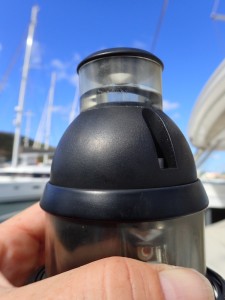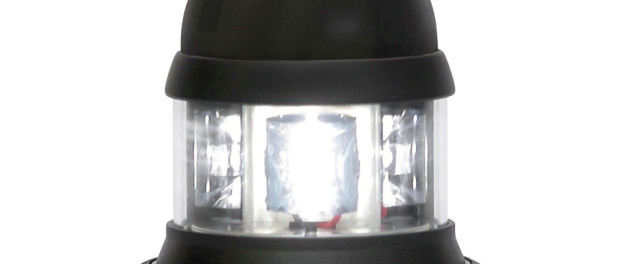Night Lights, Burn Bright
Anchor Lights: As an example of the many things I’ve learned since I became a cruiser, anchor lights are not on anchors; rather they are lights at the top of the mast turned on at night when a boat is at anchor. Anchor lights warn low-flying aircraft away from boats’ masts, and help people in the water see other boats at night too.
There are Coast Guard requirements for the use of anchor lights (I’ve copied Rule 30 of the US Coast Guard’s Navigation Rules for Anchored Vessels and Vessels Aground at the bottom of this post).
Red or White? Have you ever noticed that some anchor lights are white and others are red? It turns out only masts over 150′ must display a red light.
Photo-Cell: Since our anchor light draws power from the battery and is not solar-charged, we want to be sure we don’t forget to turn it on at dusk, and equally importantly, off at dawn. To automate this process, Rand installed a photocell that turns the light on at dusk and off at dawn automatically.
 Water Seepage: Our second challenge was the brightness of the lights. We noticed that our anchor light seemed to be dimmer than it used to be. We wondered why, so we went up the mast and brought it down. To our surprise, water had somehow gotten into the cap, dimming the light, most likely from wind-driven rain and a loose seal.
Water Seepage: Our second challenge was the brightness of the lights. We noticed that our anchor light seemed to be dimmer than it used to be. We wondered why, so we went up the mast and brought it down. To our surprise, water had somehow gotten into the cap, dimming the light, most likely from wind-driven rain and a loose seal.
We removed the cap, cleaned and dried it, and reattached it with greasy sealant and have noticed that the light now stays bright through rain, 40 knot winds, and ocean passage, so we feel the problem is solved. Still, we will take it down periodically to inspect it and be sure it’s remaining dry inside the light chamber.
Additional Night Lights: In addition to our anchor light to help us find our boat in a crowded anchorage, we leave on our solar-powered Luci light in the cockpit. Its illumination creates a glow that sets Golden Glow apart from other boats in the harbor (thanks Neil & Shawn Sullivan for introducing us to this handy light). Lucis come in color-changing
Alarm Light: Rand also set up our alarm system so when we turn off our alarm, this turns on our cockpit lights for a minute or two – enough time for us to board with light on a dark night.
Rule 30:
- (a) A vessel at anchor shall exhibit where it can best be seen:
- (i) in the fore part, an all-round white light or one ball;
- (ii) at or near the stern and at a lower level than the light prescribed in subparagraph (i), an all-round white light.
- (b) A vessel of less than 50 meters in length may exhibit an all-round white light where it can best be seen instead of the lights prescribed in paragraph (a) of this Rule.
- (c) A vessel at anchor may , and a vessel of 100 meters and more in length shall, also use the available working or equivalent lights to illuminate her decks.
- (d) A vessel aground shall exhibit the lights prescribed in paragraph (a) or (b) of this Rule and in addition, if practicable, [Inld] where they can best be seen;
- (i) two all-round red lights in a vertical line;
- (ii) three balls in a vertical line.
- (e) A vessel of less than 7 meters in length, when at anchor not in or near a narrow channel, fairway or where other vessels normally navigate, shall not be required to exhibit the shape prescribed in paragraphs (a) and (b) of this Rule.
- (f) A vessel of less than 12 meters in length, when aground, shall not be required to exhibit the lights or shapes prescribed in subparagraphs (d)(i) and (ii) of this Rule.
- (g) A vessel of less than 20 meters in length, when at anchor in a special anchorage area designated by the Secretary, shall not be required to exhibit the anchor lights and shapes required by this Rule.


Leave a comment